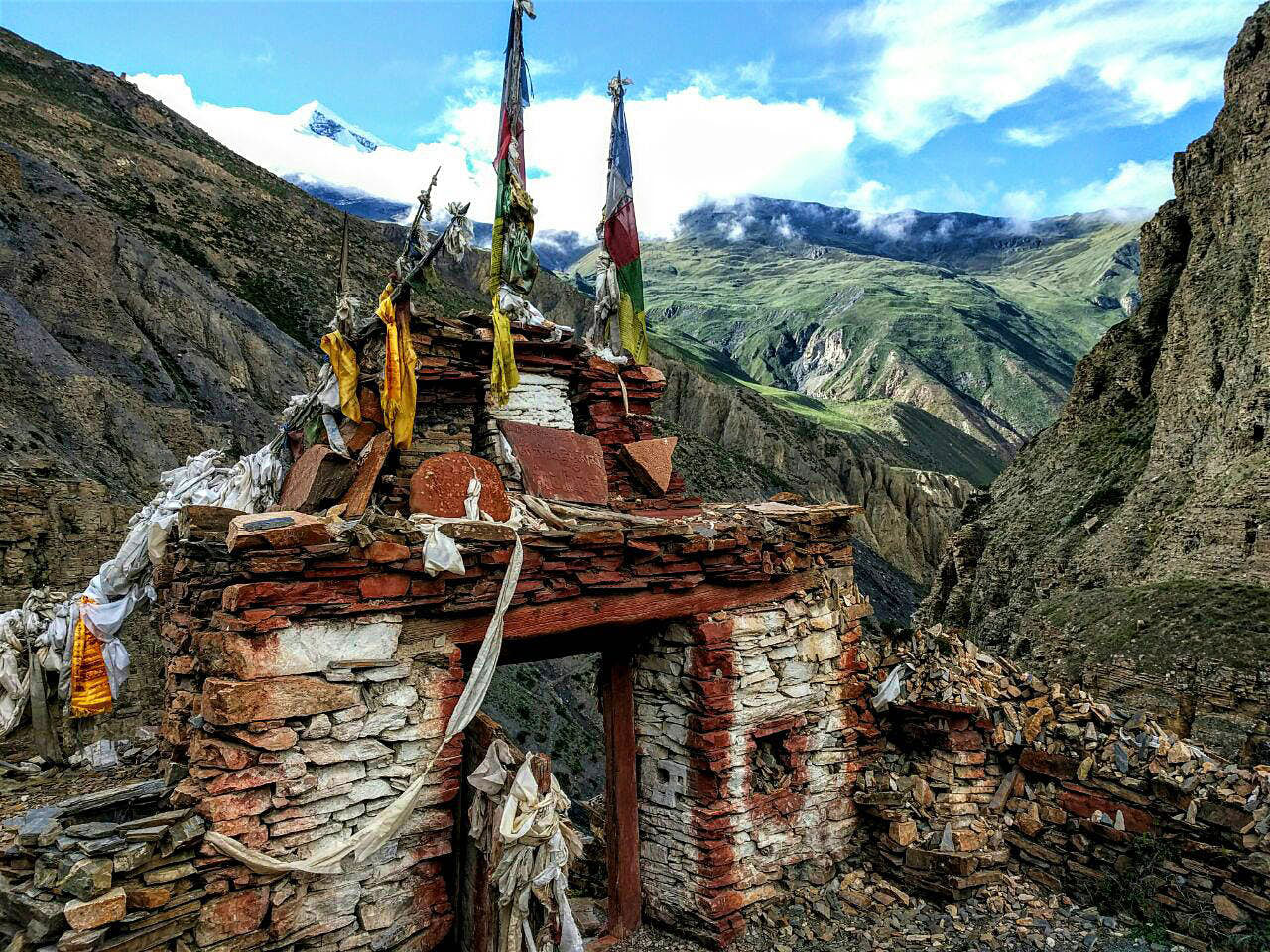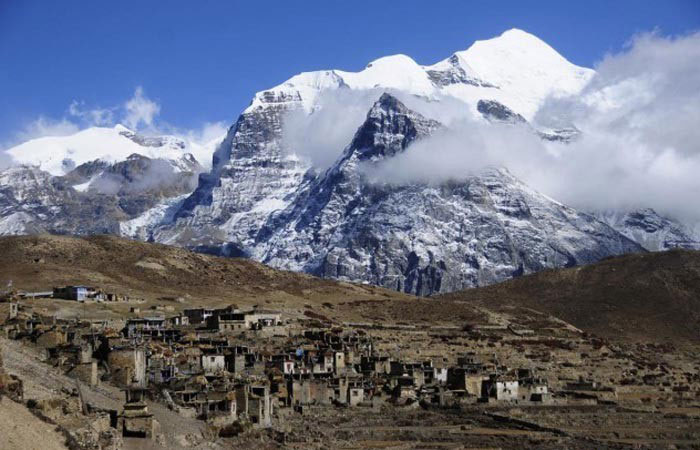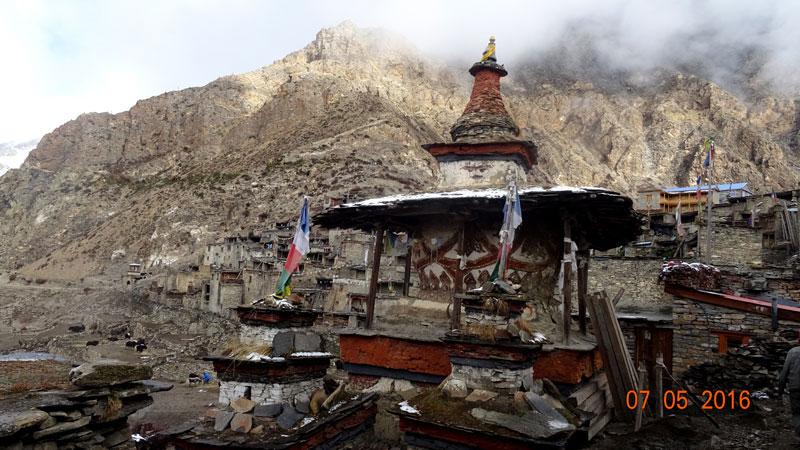Leaving the Annapurna Circuit Trail
You will start your journey through Annapurna Circuit part one in the beginning through the places of Besisahar, Jagat, Dharapani and Koto. In the company of an mandatory guide,Koto a small village on the Annapurna Circuit route, saying goodbye to the creature comforts of pizza, apple pie and Facebook updates. After few minutes of joining the narrow, unmarked trail, the number of trekkers slowed to a trickle. For the next seven days, you would see more porters than trekkers on this 'blink and you'd miss it' track. With no roads or mechanical transfers, all goods to Nar Phu is carried by mule, yak or human muscle.
Climbing upwards through green conifer forests above the raging white-water of the Nar Khola, there was little to do but soak up the sounds of nature. A cluster of basic teahouses (food stalls) made for a pleasant lunch stop before the trailhead an increasingly vertiginous path towards the tree line. Excitedly, you will gain the ridge at a lonely chorten (stupa) and basked in front of astounding views of the coming route – aloof, snow-capped peaks, brittle, jagged cliffs, and deep, plummeting gorges. Today you will gain big elevation to Meta (3530m) from Koto.
 Kaani - Anancient entrance gate in Phu Village
Kaani - Anancient entrance gate in Phu Village
After crossing the stream on a wobbly suspension bridge, We will spot a dusty mule trail zigzagging west, high above the gravity-defying monastery of Mahendra Pul also known as Nar Phedi, but that would come later in the trek. First, you need to tackle the barren ridges and sheer rock walls of the winding Phu valley, striking north towards Tibet. You could feel the altitude as I rolled into Meta (3530m), set in a high bowl on the valley side, where a simple two lodges offers stays and meals.
Striking north to Phu
An extra day for acclimatization is essential, generally we plan to have a extra day in Phu that allows the visitor to explore around but if one have feeling of Meta is acclimatization point, we can have extra night at Meta, passing the time with a calm day hike towards the base camp of Kang Garu peak (6981m), before continuing north, on a path that dipped in and out of deep ravines as it slowly twisted towards Phu. As effects of the Annapurna rain shadow, the area has became ever more rougher and drier, with fantastically eroded cliffs and gnarled, stunted juniper bushes.
There are chances of hearing stone dislodged from above, see the slopes for a glimpse of wild tahr (mountain goat) and naur (blue sheep), both often seen on these rugged trails. Eventually, the trail climbs onto the high pastures around ruined Chyakhu (3700m), where a brace of bhattis serves up a welcome meal of daal bhaat, fuel for the final push to Phu. It takes some more hours; follow a narrow, sheer gorge, to reach the crumbling entrance gate to Phu. The village itself though was still half an hour away, and you will be happy to drop the pack when you are finally at Phu's solitary lodge.

Mt. Kangaru towering high above Nar Phu village
It's wise to use two days in Phu because of the elevation, a giddy 4070m and the time to explore the village, a stack of Tibetan-style mud and stone houses, bedecked with prayer flags and crowned by stacks of firewood. The upper part of Phu village suffered extensive earthquake damage and was mostly in ruins, but a set of steep switchbacks delivers you to the doorstep of Tashi Lhakhang Gompa (monastery), further up the ridge, where a friendly occasionally nun offers a cup of butter tea and invites to view the shrine's inner sanctum.
Those with time could spend several happy days exploring the ridges around Phu. Above Tashi Lhakhang Gompa, with its 360 degree scenery, a wild trail strikes north towards Tibet, and trail dropping down from Saribung Pass while a more easterly track tracks the glacial moraine to Himlung Base camp (4920m). For less ambitious trekkers, there are awe-inspiring views from the bowl-shaped hanging valley that perches enticingly atop the terraced fields rising above Phu village.
Winding west to Nar
After exploring Phu, you retrace our steps back along the Phu Khola, striking west just before Meta on the same trail you will see your way north. A low suspension bridge at the base of eroded hoodoos provided access to the charming monastery at Nar Phedi (3490m), set on a serene ledge surrounded by fluttering prayer flags, nightmare ravines and sawtooth pinnacles. Despite their humble circumstances, the monks offer basic lodging and meals for trekkers and one can observe their evening puja (prayer) ceremony before joining in a hearty communal meal.
Your sleep may come easier at this lower altitude, and can be well rested for the climb to Nar. A twisting trail leads up above the clouds, passing scattered mule trains and an atmospheric octagonal chorten, before a bend in the trail reveals the green barley fields of Nar village (4180m), stacked against the hillside. This day you have plenty of time to explore the dirt paths winding between stone houses and ancient Kagyud school gompas, and that evening
Reaching this lofty eyrie is a much more challenging undertaking than the legendary Thorung La (5416m) on the Annapurna Circuit. Above Nar, benign pastures soon give way to lose scree and rocky moraine, and a crudely-defined path, switches back and forth past tattered prayer flags, to reach several spirit-crushing false summits before finally cresting the misty, knife-edge pass. Gasping for breath, I paused to take a congratulatory selfie on the boot-wide high-point and scanned the landscape. You can see houses of Manang in distant, the thin ribbon of Humde airstrip, and the main Annapurna circuit, two vertical kilometres below, while the snow-capped crags of Annapurna III and IV hijacked the horizon. The thrilling Kang La Pass may get closed if there is bad weather and heavy snow fall.
.jpg) The Buddhist Monastery in Nar Phedi
The Buddhist Monastery in Nar Phedi
The final day promised long hours of testing trekking, cautious downhill walk to Ngawal Ngawal (3750m), the final stop on the trek. Nevertheless, your knees may be close to crumpled you finally roll into the village, where the Annapurna Circuit trinity of banana pancakes, apple pie and wi-fi awaited. After a week off the apple-pie trail, again you are happy to rejoin Annapurna Circuit trail.
Nar Phu Trek Permit
Nar Phu valley is a controlled area, and trekkers are allowed to enter with a special permit only, which is only issued through a registered trekking company that will also arrange the mandatory licensed guide. The cost for the Nar Phu permit is ranged from US$75 to $90 depending on the season; your permits are valid for only seven days so you must complete the trek in stated time. Be aware of the risk of Acute Mountain Sickness (AMS) on this route; there is a large altitude gain from Koto to Meta and it is essential to be acclimatized to conditions above 3000m before attempting this trek. The trek to Nar Phu is just one of a string of epic trails climbing through Nepal's 'restricted areas', remote valleys tucked against the Tibetan border. With the right permits (and enough budget for the steep fees), you can set your sights on former Buddhist kingdoms, timeless Tibetan gompas and rarely-trodden valleys dotted with the paw-prints of rarely spotted snow leopards. Consider the following spectacular trails:

An ancient chhorten in Nar Village
Camping Trek Itinerary
Day 01: Kathmandu to Jagat.
Day 02: Jagat to Dharapani 1860m (5/6 hours)
Day 03: Dharapani to Koto 2600m (5/6 hours)
Day 04: Trek to Dharmasaala (Shelter available, needs own food)
Day 05: Meta to Kyang 3840m) (4 hours), No accommodation, yak hut available. Need to camp.
Day 06: Kyang to Phu 4080m (3/4 hours)
Day 07: Explore around Phu, or excursion to Himlung Base Camp.
Day 08: Phu to Nar Phedi 3,490m (5/6 hours) Camping and basic lodging and meals available in the monastery.
Day 09: Trek to Nar Village 4,110m (2/3 hours)
Day 10: Trek to Kang La Phedi (only camping)
Day 11: Trek to Ngawal (3,675m) via the Kang La Pass (5,240m)
Day 12: Ngawal to Manang (3,540m.) 3-4 hours walk.
Teahouse Trek Itinerary
Day 01: Kathmandu to Jagat.
Day 02: Jagat to Dharapani 1860m (5/6 hours)
Day 03: Dharapani to Koto 2600m (5/6 hours)
Day 04: Koto to Meta 3570m (7-8 hours) big elevation gain (Beware of AMS - Alititude Mountain Sickness)
Day 05: Meta to Phu 4080m (6-7 hours)
Day 06: Extra day in Phu. Explore around.
Day 07: Phu to Nar Phedi 3,490m (5/6 hours), Basic accommodation and meals available in the monastery.
Day 08: Trek to Nar Village 4,110m (2/3 hours)
Day 09: Trek to Ngawal (3,675m) via the Kang La Pass (5,240m)
Short Teahouse Trek Itinerary for Regular Experienced Hikers
Day 01: Kathmandu to Jagat.
Day 02: Jagat to Dharapani 1860m (5/6 hours)
Day 03: Dharapani to Koto 2600m (5/6 hours)
Day 04: Koto to Meta 3570m (7-8 hours) big elevation gain (Beware of AMS)
Day 05: Meta to Phu 4080m (6-7 hours)
Day 06: Extra day in Phu. Explore around.
Day 07: Trek to Nar Village 4,110m ( 7-8 hours)
Day 08: Trek to Ngawal (3,675m) via the Kang La Pass (5,240m),7-8 hours.


 Kaani - Anancient entrance gate in Phu Village
Kaani - Anancient entrance gate in Phu Village
.jpg) The Buddhist Monastery in Nar Phedi
The Buddhist Monastery in Nar Phedi





